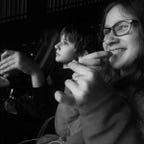Dreams and Windows: Contemplating Character at the William King Museum of Art
Almost 30 years ago, I had a dream which I still remember vividly. In the dream, I had a jovial conversation with a man who was seated, decked out in mid-century evening dress, and full of laughter. And when I woke, I knew exactly where I had encountered this man: in a portrait. Either that same day, or perhaps a few days before, I had visited a major exhibit of the works of artist James Gunn in the Scottish National Portrait Gallery in Edinburgh; and though I didn’t know who the sitter was (Sir William Darling, as it happens), this painting made such an impression that he came to life for me in the dream. I felt that I knew his demeanor, how he sounded, even how he moved.
Such is the power of portraiture.
The William King Museum of Art’s current visiting exhibit, Contemplating Character, examines that power from multiple angles. There are many windows into a portrait: the life of the subject, the vision of the artist, the context of the time period, the circle of family and friends, the nature of fame, the breadth of human imagination, the remnant in loss and grief. These windows are opened for us by the exhibit’s curator, who also happens to be the exhibit’s collector, Robert Flynn Johnson. Arranging the portraits by theme or subject matter, Johnson opens these windows in his excellent labels, and cleverly lets the works converse with each other across sections.
For example, in the self-portrait section we meet the remarkable French painter Louis Joseph César Ducornet, born without arms but able to use his feet and mouth to paint. Ducornet shows us himself resting from a painting, looking straight at the viewer, a welcoming smile on his lips. But on the opposite wall, in a section on portraits of artists, we meet Ducornet as painted by Jean-Pierre Dantan. Here his mouth holds a paintbrush firmly, and his focus is completely occupied by his painting. We see through many windows here: Ducornet’s welcoming presentation of himself; Dantan’s insight into the intense miracle of Ducornet’s work; the challenges facing a disabled painter; the choices involved in painting oneself or a friend; the way that the collector spotted these images, arranged them, labelled them.
Listening to this conversation between portraits, guided by Johnson’s insight, we are introduced to César Ducornet in ways that words alone cannot capture.
These conversations between sections reveal more in repeated visits. Caricature has a long history here, and we see it stretching from revolutionary France to the aesthetic movement in England — Aubrey Beardsley’s portrayal of (probably) Oscar Wilde stands out. Those who recall Alfred Hitchcock Presents will recognize his self-caricature, while Frederick Judd Waugh’s self-portrait caricatures the Modernist artists of his own day. Thanks to its inclusion here, we can set caricature in conversation with more traditional forms of portraiture, and consider how each reveals its subject and its artist.
There is so much of human life in this exhibit. The disturbed, brilliant mind of Richard Dadd, held in Bethlehem (Bedlam) Hospital for the murder of his father; the tiny eye portrait, a sign of affection; the heartbreaking image of a painter’s own daughter on her deathbed, with locks of her hair. Two self-portraits by Adolfe-Félix Cals show us the simple, universal contrast between a good day and a bad day. Several paintings are by the German Adolf Friedrich Erdmann von Menzel, of whom we learn much — his short stature, his interest in depicting the elderly, his compulsion to draw portraits in offhand moments, and his immense skill. A series of silhouettes of preacher Charles Simeon in action offers a unique glimpse of the physical action that attended his widely-read sermons. All these windows are full of light, and they shine into each other.
Beyond the connections and the context, there is simply so much beauty on display — the beauty of the human form, and the beauty of art.
In the end, what makes this exhibit so remarkable is how it connects to its guests. The author Frederick Buechner says that reading memoir is like looking through someone else’s photo album: you might see a place you recognize, or you might see yourself, or best of all you might then gaze through your own life and see “the sacredness of your own journey.” Contemplating Character invites us, in the end, to look into the window to ourselves, to see how we connect to these people we never knew, and perhaps how we might be seen by them.
The presence of this exhibit at the William King Museum of Art is a testimony both to the WKMA’s remarkable reach and Robert Flynn Johnson’s generosity with his own collection. The exhibit is a window into Johnson himself, whose keen eye and curatorial savvy are everywhere in evidence, and it’s also a window into the mission of the WKMA. Here is a museum which looks both far afield and close to home; across the hall is a display of quilts, upstairs are dazzling costumes from the Barter Theatre. The WKMA is an ongoing gift to the whole region, always changing, and this exhibit is a gem.
Go see Contemplating Character through July 30, and look through the many windows this exhibit flings open. You’ll meet people both strange and familiar, flawed and famous, beckoning and reserved, through the power of portraiture.
You might even dream about one.
